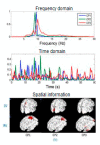EEG-Based BCI Emotion Recognition: A Survey
- PMID: 32906731
- PMCID: PMC7570756
- DOI: 10.3390/s20185083
EEG-Based BCI Emotion Recognition: A Survey
Abstract
Affecting computing is an artificial intelligence area of study that recognizes, interprets, processes, and simulates human affects. The user's emotional states can be sensed through electroencephalography (EEG)-based Brain Computer Interfaces (BCI) devices. Research in emotion recognition using these tools is a rapidly growing field with multiple inter-disciplinary applications. This article performs a survey of the pertinent scientific literature from 2015 to 2020. It presents trends and a comparative analysis of algorithm applications in new implementations from a computer science perspective. Our survey gives an overview of datasets, emotion elicitation methods, feature extraction and selection, classification algorithms, and performance evaluation. Lastly, we provide insights for future developments.
Keywords: BCI; classification; emotion; extraction; feature; preprocessing; recognition; selection; survey; trends.
Conflict of interest statement
The authors declare no conflict of interest.
Figures












References
-
- Picard R.W. Affective Computing for HCI; Proceedings of the HCI International 1999-Proceedings of the 8th International Conference on Human-Computer Interaction; Munich, Germany. 22–26 August 1999.
-
- Goenaga S., Navarro L., Quintero C.G.M., Pardo M. Imitating human emotions with a nao robot as interviewer playing the role of vocational tutor. Electronics. 2020;9:971. doi: 10.3390/electronics9060971. - DOI
-
- Kitcheman B. Procedures for performing systematic reviews. [(accessed on 26 May 2020)];Comput. Sci. 2004 :1–28. Available online: http://www.inf.ufsc.br/~aldo.vw/kitchenham.pdf.
Publication types
MeSH terms
LinkOut - more resources
Full Text Sources

